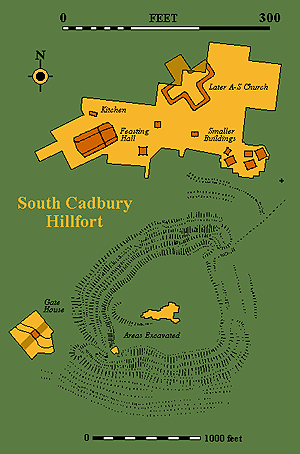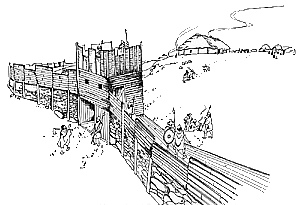
EBK Home
Kingdoms
Royalty
Saints
Pedigrees
Archaeology
King Arthur
Mail David
CADBURY CASTLE
Arthur's Camelot or Dumnonian Capital?
 Modern
opinion as to the whereabouts of King Arthur's Court, whether it was named
Camelot or not, tends to lean towards the enormous refortified hillfort at
South Cadbury in Somerset. Is this merely due to a massive amount of
publicity and modern propaganda, or is it a real possibility?
Modern
opinion as to the whereabouts of King Arthur's Court, whether it was named
Camelot or not, tends to lean towards the enormous refortified hillfort at
South Cadbury in Somerset. Is this merely due to a massive amount of
publicity and modern propaganda, or is it a real possibility?
The Tradition: The stories of King Arthur at the hillfort of South Cadbury, near the villages of Queen and West Camel, are actually not particularly old. The travelling historian, John Leland, first recorded the association in 1542:
"Right at the South end of South Cadbury Church stands Camelot. This was once a noted town or castle, set on a real peak of a hill, and with marvellously strong natural defences..... Roman coins of gold, silver and copper have been turned up in large quantities during ploughing there, and also in the fields at the foot of the hill, especially on the East side. Many other antiquities have also been found, including at Camelot, within memory, a silver horseshoe. The only information local people can offer is that they have heard that Arthur frequently came to Camelot."
Local people also believed that King Arthur and his knights slept in a hidden cave beneath the hillfort. When archaeological research first began there, an old man from the village asked anxiously if the excavators had come to remove the King.
 Modern
Archaeology: Taking their lead
from Leyland's writings, in 1965, the Camelot Research Committee was set
up to excavate large areas of the South Cadbury Hillfort. They soon
discovered that the fort had indeed been re-fortified in post-Roman times.
The ramparts were strengthened with large quantities of dressed masonry
from derelict Roman buildings and mounted by raised wooden walkways. These
were pierced at the South-West corner by a sturdy wooden gate-house
through which passed a cobbled roadway (10ft across). The remains of a
large timber feasting hall (63 by 34 feet) with an internal partition
towards the east end were discovered at the centre of the site. It was
easily dated to the 5th/6th centuries from large amounts of imported
Mediterranean pottery scattered over the floor and in the postholes.
Similar pottery was discovered in a possible kitchen just to the north.
Smaller buildings in the surrounding area were of uncertain date. The
whole area probably went out of use in the early 7th century, but there
was extensive evidence for the use of the fort in later ages. The most
interesting was perhaps the discovery of an unfinished cruciform Saxon
Church from the fort's time as one of King Aethelred's defensive Burghs.
Modern
Archaeology: Taking their lead
from Leyland's writings, in 1965, the Camelot Research Committee was set
up to excavate large areas of the South Cadbury Hillfort. They soon
discovered that the fort had indeed been re-fortified in post-Roman times.
The ramparts were strengthened with large quantities of dressed masonry
from derelict Roman buildings and mounted by raised wooden walkways. These
were pierced at the South-West corner by a sturdy wooden gate-house
through which passed a cobbled roadway (10ft across). The remains of a
large timber feasting hall (63 by 34 feet) with an internal partition
towards the east end were discovered at the centre of the site. It was
easily dated to the 5th/6th centuries from large amounts of imported
Mediterranean pottery scattered over the floor and in the postholes.
Similar pottery was discovered in a possible kitchen just to the north.
Smaller buildings in the surrounding area were of uncertain date. The
whole area probably went out of use in the early 7th century, but there
was extensive evidence for the use of the fort in later ages. The most
interesting was perhaps the discovery of an unfinished cruciform Saxon
Church from the fort's time as one of King Aethelred's defensive Burghs.
Modern Publicity: The very name of the Camelot Research Committee gave the impression that the excavations at South Cadbury were specifically looking for King Arthur's Court and therefore, if anything from the appropriate period was discovered, obviously that's exactly what it must represent. Of course, the excavations came up trumps and the media were very quick to jump onto the King Arthur band wagon; not to mention the local Somerset tourist industry which now won't hear of any other site being suggested as "Camelot".
 Possible
Interpretations: Only an
important British chieftain could have afforded to trade in such lavish
imports and build on the scale discovered at South Cadbury. Surely, the
comparability with the known Royal Deiran Hall at Yeavering
(Northumberland), indicates the builder was a King. Furthermore, the
incomparable size of the Cadbury fort has led to the suggestion that a
High-King such as Arthur would be the most likely resident. However,
Cadbury lay within the Kingdom of Dumnonia, and there seems little reason
to doubt that it was the capital of the Dumnonian Kings. Such a
prestigious settlement would warrant the use of the biggest hillfort in
the area. It probably took over from the nearby deserted Roman Town of
Caer-Pensawel-Coyt (Ilchester). This theory is highly strengthened by a
possible interpretation of the fort's name. Usually translated as
Battle-Fort, Cadbury may really mean Cado's Fort: Cado
being the name of an early 6th century King of Dumnonia! Barber
& Pykitt suggest the Arthurian connection was due to confusion
with a, now forgotten, association with the pre-Roman King Arviragus.
Possible
Interpretations: Only an
important British chieftain could have afforded to trade in such lavish
imports and build on the scale discovered at South Cadbury. Surely, the
comparability with the known Royal Deiran Hall at Yeavering
(Northumberland), indicates the builder was a King. Furthermore, the
incomparable size of the Cadbury fort has led to the suggestion that a
High-King such as Arthur would be the most likely resident. However,
Cadbury lay within the Kingdom of Dumnonia, and there seems little reason
to doubt that it was the capital of the Dumnonian Kings. Such a
prestigious settlement would warrant the use of the biggest hillfort in
the area. It probably took over from the nearby deserted Roman Town of
Caer-Pensawel-Coyt (Ilchester). This theory is highly strengthened by a
possible interpretation of the fort's name. Usually translated as
Battle-Fort, Cadbury may really mean Cado's Fort: Cado
being the name of an early 6th century King of Dumnonia! Barber
& Pykitt suggest the Arthurian connection was due to confusion
with a, now forgotten, association with the pre-Roman King Arviragus.
